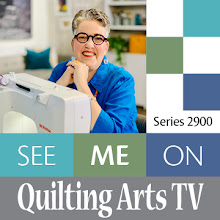
Quilt (untitled, detail) by Margory Eberle of Weaverville, NC. Quilted by Joyce Fong.
Hummingbirds 2 by Penelope Wortman of Candler, NC, with Ellen Perkins.
Neighbor Ladies by Margaret Hunt of Clarks Hill, SC.
Go With the Flow: Water, Wind and Music by Patty Ashworth of Oak Ridge, TN.
Round Midnight by Caroline Manheimer of Asheville, NC. Quilted by Rachel Reese.
View of the mountains from the North Carolina Arboretum.
Summer Beauties by Judy Heyward of Mt. Pleasant, SC. This quilt won a ribbon for Outstanding Machine Workmanship.
Vintage Button Bouquet by Linda Roy of Knoxville, TN, won a ribbon for Outstanding Hand Workmanship.
Ring Around the Posey by Elizabeth Miller of Charlotte, NC.
Under the Watchful Eye of Queen Charlotte II by Deborah Langsam of Charlotte, NC.
Arabian Mystery by Judy Heyward of Mt. Pleasant, SC.
Birder’s Fantasy by Mary Field of Asheville, NC.
Seasons III by Beverly Hertler of Red Bank, NJ.
Mini Madness (miniature quilt) by Kristin Kipper of Greer, SC.
Celebrating 75 Years of the Blue Ridge Parkway by members of the Asheville Quilt Guild: Julie Bagamary, Georgia Bonesteel, Ann Bordeau, Robin Brooks, Connie Brown, Laura Casey, Donna Faber, Norene Goard, Amy Harry, Yolanda Hall, Judy Heyward, Ira Inman, Maureen Kampen, Lynda Kepler, Ellen Levine, Janice Maddox, Nancy Matthewson, Linda Nichols, Diana Ramsay, Sharon Smaldone and Rita Williams. Quilted by Norene Goard.
Quilting the Garden by Renate Jaeger of Jonesborough, TN. (The design is from the book of the same name by Alma Allen and Barb Adams.)
Capriccio by Norene Goard of Hendersonville, NC.
I was charmed to see this kind gentleman patiently escorting a woman in a wheelchair (perhaps his wife?) who was dressed entirely in pink. I snapped this photo of them in front of my quilt, Pink Petal Party.
Friendly Gathering by Gail Sexton of Sunset, SC.
Flip-Flop Paper Piecing by Mary Kay Mouton of Milledgeville, GA. This tiny miniature quilt won Best of Show. Mouton is the author of a book (also called Flip-Flop Paper Piecing) about this technique.
Faces from the Past by Judy Simmons of Fletcher, NC.





















































































